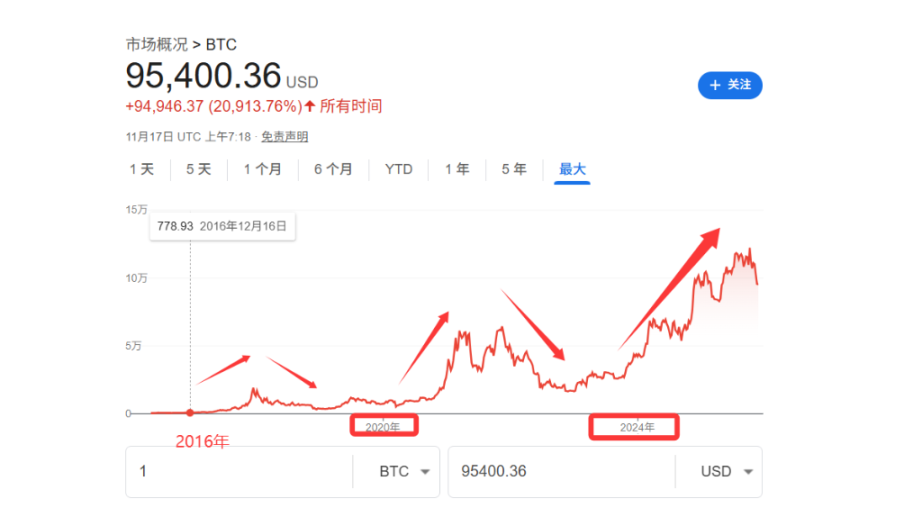Market value evaporates by 60 billions! Faith shaken, institutions on the sidelines—has bitcoin’s “post-halving crash” curse come true?
A major reason for the recent plunge is market concerns over a repeat of the "halving cycle"—that is, after a supply reduction triggers a boom, a deep correction inevitably follows. Panic selling by investors, combined with a stagnation of institutional funds and macroeconomic headwinds, have collectively led to a collapse in market confidence.
Bitcoin recently experienced a flash crash at its highs, briefly falling below $93,000, wiping out $60 billions in market capitalization, and erasing all gains for the year. One of the main reasons for this sharp decline is market concerns over a repeat of the "halving cycle"—that is, after a supply reduction triggers a boom, it is inevitably followed by a deep correction. Panic selling by investors, combined with a halt in institutional inflows and macro headwinds, has collectively led to a collapse in market confidence.
Written by: Long Yue
Source: Wallstreetcn
After hitting an all-time high this October, Bitcoin's price has plummeted sharply in recent days, at one point erasing all gains made in 2025.
Yesterday, Bitcoin's price briefly fell below $93,714 (UTC+8). This price level is already below its closing price at the end of 2024, meaning that the annual gain of over 30% at one point this year has been "completely wiped out."
Latest data shows that compared to the October peak, Bitcoin's total market capitalization has evaporated by about $60 billions. This rapid, fierce, and seemingly triggerless decline has caught the entire market off guard.
For an asset where volatility is the norm, what sets this episode apart is the speed at which market confidence has evaporated. This downturn occurred in a year when Bitcoin's legitimacy was supposed to be consolidated—the approval of spot ETFs brought crypto assets into mainstream investment portfolios, and the Trump administration's public support further boosted market sentiment.
However, reality has fallen short of expectations. Anxiety is spreading across trading floors and social media, with traders revisiting old charts in search of answers from history.
Boom First, Bust Later—Is the Halving Cycle Repeating?
According to a recent analysis by Bloomberg, in the absence of traditional financial asset analysis frameworks, some market participants have defaulted to the model they know best: the four-year "halving" cycle. Historically, this mechanism—designed to halve the new supply of Bitcoin—often triggers speculative booms, followed by painful busts.
In this cycle, the halving occurred in April 2024. Subsequently, Bitcoin's price peaked in October this year (UTC+8), roughly in line with previous patterns. However, as well-capitalized institutional investors reshape the market, it remains uncertain whether this old script still applies.

Matthew Hougan, Chief Investment Officer at Bitwise Asset Management, believes, "People are worried that the four-year cycle may repeat, and they don't want to go through another 50% correction. So they're preemptively avoiding risk by pulling out of the market." This concern over history repeating itself may, in itself, constitute selling pressure.
Weak Market Sentiment, Bullish Conviction Shaken
This round of decline also reflects market exhaustion and disappointment. Some retail investors suffered heavy losses chasing high-flying crypto concept stocks. Then, in early October, an unexpected escalation in trade tensions triggered massive liquidations amid surging leverage. As a result, the market held excessive expectations for the future, but actual conviction was extremely fragile—once sentiment reversed, there was no strength to absorb the selling pressure.
Jake Kennis, an analyst at crypto data firm Nansen, pointed out, "Currently, Bitcoin trades more like a macro asset embedded in institutional portfolios, reacting more to liquidity, policy, and dollar dynamics than to predictable supply shocks."
Despite ongoing discussions about institutionalization, market trading is still largely driven by "sentiment." And right now, market sentiment is terrible, and risk appetite has reversed.
Institutional Inflows Stalled, Premiums Disappear
Earlier this year, spot Bitcoin ETFs attracted billions of dollars, successfully recasting Bitcoin as a macro hedging tool. However, recent capital flows have stalled.
Some long-term holders have chosen to cash out and exit, while industry representative companies like Strategy Inc. have seen their share prices approach the value of their Bitcoin holdings—a clear signal that the market is no longer willing to pay a premium for the "belief" in holding Bitcoin.
This phenomenon suggests that even institutional investors have cooled in their enthusiasm. When even the staunchest supporters no longer receive extra rewards from the market, broader investor confidence is naturally eroded.
Macro Headwinds and Competition from Alternative Assets
The Trump administration's pro-crypto stance has not shielded Bitcoin from macroeconomic headwinds. Meanwhile, it also faces fierce competition from new speculative favorites such as artificial intelligence (AI), stablecoins, and prediction markets. With gold and stock prices near all-time highs, Bitcoin's performance pales in comparison.
Mike McGlone, Senior Commodity Strategist at Bloomberg Intelligence, stated that Bitcoin is "the tip of the iceberg of risk assets, and it's melting." He expects that "Bitcoin and most cryptocurrencies will continue to decline."
Although the market infrastructure remains intact, for those who once hoped Bitcoin would reach $200,000 by year-end, the recent plunge is undoubtedly a heavy blow.
Eric Balchunas, ETF analyst at Bloomberg Intelligence, believes that traders' anxiety over history repeating itself may have "led to a self-fulfilling four-year cycle." But he also adds, "The typical rhythm may be temporarily disrupted, or even permanently changed."
Derek Lim, Head of Research at crypto market maker Caladan, offers another perspective. He believes the bull markets of 2017 and 2021 were not simply driven by halvings, but by "a stronger, more fundamental force: global liquidity." He adds that with the end of the U.S. government shutdown, such liquidity may return.
Disclaimer: The content of this article solely reflects the author's opinion and does not represent the platform in any capacity. This article is not intended to serve as a reference for making investment decisions.
You may also like
Young Bitcoin holders panic sell 148K BTC as analysts call for sub-$90K BTC bottom

Rare Bitcoin futures signal could catch traders off-guard: Is a bottom forming?

XRP traders hope fresh wave of ETF launches will restore the bull trend

Aster announces a $10 million trading competition, combined with Stage 4 airdrop and Rocket Launch incentives, driving multi-layered growth in platform depth and liquidity.
After achieving strong performance in Stage 3, Stage 4 (Harvest) airdrop plan was launched, and the “Double Harvest” trading competition with a total reward of 10 million USD will be introduced on November 17.

